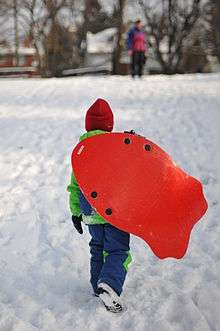Toboggan
A toboggan is a simple sled which is a traditional form of transport used by the Innu and Cree of northern Canada.

In modern times, it is used on snow to carry one or more people (often children) down a hill or other slope for recreation. Designs vary from simple, traditional models to modern engineered composites. A toboggan differs from most sleds or sleighs in that it has no runners or skis (or only low ones) on the underside. The bottom of a toboggan rides directly on the snow. Some parks include designated toboggan hills where ordinary sleds are not allowed and which may include toboggan runs similar to bobsleigh courses.[1]
Toboggans can vary depending on the climate and geographical region. Such examples are Tangalooma (Australia) where toboggans are made from Masonite boards and used for travelling down steep sand dunes at speeds up to 40 km/h (25 mph).
Overview
The traditional toboggan is made of bound, parallel wood slats, all bent up and backwards at the front to form a recumbent 'J' shape. A thin rope is run across the edge of end of the curved front to provide rudimentary steering. The frontmost rider places their feet in the curved front space and sits on the flat bed; any others sit behind them and grasp the waist of the person before them.
Modern recreational toboggans are typically manufactured from wood or plastic or aluminum. Larger, more rugged models are made for commercial or rescue use.

The Mountaineer [Innu] method is the only one adapted for the interior parts of the country: their sleds are made of two thin boards of birch; each about six inches broad, a quarter of an inch thick, and six feet long: these are fastened parallel to each other by slight battens, sewed on with thongs of deer-skin; and the foremost end is curved up to rise over the inequalities of the snow. Each individual who is able to walk, is furnished with one of these; but those for the children are proportionately less. On them they stow all their goods, and also their infants; which they bundle up very warm in deer-skins. The two ends of a leather thong are tied to the corners of the sled; the bight or double part of which is placed against the breast, and in that manner it is drawn along. The men go first, relieving each other in the lead by turns; the women follow next, and the children, according to their strength, bring up the rear; and, as they all walk in rackets (snowshoes), the third or fourth person finds an excellent path to walk on, let the snow be ever so light.[2]
In popular culture
The toboggan is a recurring prop in the Calvin and Hobbes comic. Comic author Bill Watterson uses it (or, alternatively, a wagon) as "a simple device to add some physical comedy to the strip, and most often use[s] it when Calvin gets longwinded or philosophical."[3]
In the film Home Alone, eight-year-old Kevin McCallister rides a toboggan down the stairs after his family "disappears".
See also
- Bobsled
- Luge
- Pulk, a Scandinavian low, flat load-carrying sled.
- Skeleton (sport)
- Sled
- Toboggan (hat)
- Bum slider
References
- Sled, Sledge, Sleigh, and Toboggan grammarist.com differentiation of sledding types
- Townsend 1911:357–358.
- Watterson, Bill (1995). The Calvin and Hobbes Tenth Anniversary Book. Kansas City, Missouri: Andrews McMeel Publishing. p. 104. ISBN 0-8362-0438-7.
External links
| Wikimedia Commons has media related to Toboggans. |
| Look up toboggan in Wiktionary, the free dictionary. |
- . New International Encyclopedia. 1905.